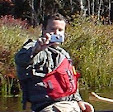 |
| Heading out |
Deerfield River arises in southern VT and flows for 76-miles through VT and MA to join with the Connecticut River in Greenfield below Turners Falls. With an 1,100-foot drop, hydroelectric development began in 1910 when the New England Power Company was formed to acquire water rights and build hydroelectric dams on the river. There are now 10 dams on the Deerfield owned by three different electric utilities. An innovative licensing agreement in 1994 increased the number of recreational releases on the class II/III Fife Brook section, and the class III/IV Dryway.
 |
| Hangover Helper |
As I left my house I saw golf bags in a neighbor’s driveway, so I knew I wasn’t the only one planning to enjoy the day. There was heavy fog as I drove up Route 91 through the Pioneer Valley, but it lifted as I headed up Route 2 to Charlemont. We met at the take out below Zoar Gap for the shuttle up to the put-in.
 |
| Above Pinball |
We put in at around 11:30 and began working our way downstream. We ran Hangover Helper, did some surfing at Carbis Bend and the ledge below Freight Train, and played in Pinball before taking a break at Miami Beach. We then ran the Island Rapid before pulling over at the take-out above Zoar Gap.
 |
| Break at Miami Beach |
Prior to 2011 there was a sneak route on the far right, but street repairs after Hurricane Irene left rocks blocking that route. There is an upper drop, with a tongue on river right, and a pour-over river left. The "beginner" line is to ride the tongue on river right and then punch through the holes below. Conrad explains it here:
Zoar Gap at 1,400 cfs from Erik Eckilson on Vimeo.
The "advanced" line is to catch the eddy below the pour-over and then go right into the eddy below the drop, or run the drop on the left. You can see Rick style the right line, and me swim the left line here:
Running Zoar Gap from Erik Eckilson on Vimeo.
Running Zoar Gap from Erik Eckilson on Vimeo.
Temp’s hit 74 degrees, so it felt like spring even though there was still snow on the ground.



No comments:
Post a Comment
Note: Only a member of this blog may post a comment.